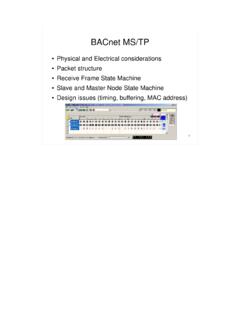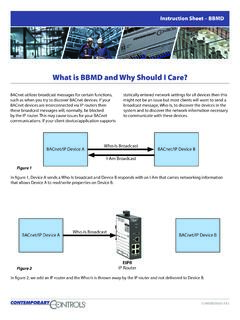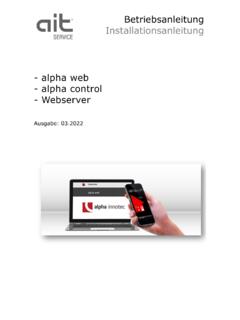Transcription of The BACnet Device ID - kargs.net
1 This article was published in Foundations, A BACnet International Publication, June 2012. BACnet International 2012 further editorial use of articles in Foundations is encouraged. Please send a copy to the BACnet International office at BACnet Device IDBy Steve Karg, Member ASHRAEThe BACnet Device ID is a commonly misunderstood term and value by newcomers to purpose is often misunderstood. This is perhaps because many developers come to BACnetfrom other protocols which do not have the extra complexity of an address resolution term " Device ID" is short for Device Identifier, and is shorthand for the Instance Number portion of the BACnet Device object Object_Identifier property. The Device ID is a non-volatile value that is chosen and configured by someone at the site where the BACnet product is installed. The Device ID is used for resolution of network layer addresses into application layer addresses, commonly referred to as "binding".
2 ObjectsBACnet uses objects to represent physical inputs, outputs, values, and processes. These objects provide a framework for BACnet messages to access and manipulate the properties of these objects. How the objects map to the real values or physical points used in the Device is what each vendor gets to choose when they develop a BACnet product. The quantity of each type of object in a BACnet product is also something that the vendor will choose. The exceptionfor choice in the quantity of objects is the Device object. Every BACnet Device has one, and only one, Device object. However, a gateway Device could represent multiple devices by having each Device appear as if they were behind a virtual BACnet object contains a number of properties. Some of the properties are required to exist in the object, such as Object_Identifier, Object_Name, and Object_Type properties. Someproperties are optional and may be supported by the vendor if that Device needs that property, or if the vendor chooses to implement a feature that mandates that an optional property be supported by that object.
3 Some properties are proprietary, or non-standard. A proprietary property is often a property that is needed by the vendor for specific object functionality, but is not defined by the standard set of properties for that object in the BACnet standard. Some properties are read-only. Some properties are IdentifiersThe Object_Identifier property, which is required in every BACnet object, is useful for uniquely referencing each object in a Device . The Object_Identifier is made of two pieces of data: an object type, and an object instance number. There are many numbers used in the BACnet protocol to communicate information on the network. Most of these numbers are prescribed and defined the standard. Object types can be any of the BACnet standard object types and are enumerated from 0 to 127, or they can be a non-standard type numbered from 128 to 1023. As an example, a Device object type is enumerated as 8.
4 The vendor of a Device can choose which types of objects are used in a Device . The object instance numbers can range from 0 to 4194302. The vendor can choose which object instance numbers are used for each object. The exception to this is the object instance number for the Device object, which can be chosen initially by the vendor, but must be configurable and survive power and controller resets (non-volatile). Device ID ValueThe BACnet standard tells us that "each object within a single BACnet Device shall have a unique value for the Object_Identifier property." It also says "..the system-wide unique Object_Identifier of the BACnet ". The standard specifies that the instance number range is 22-bits: 0-4194303. It also states that "No object shall have an Object_Identifier with an instance number of 4194303."The only method to make a system-wide unique Device ID from 0 to 4194302 is to have this value configurable at the building site where the BACnet product is installed.
5 This can be accomplished in a variety of ways, from a user interface on the product to simply allowing the Device object Object_Identifier property to be writable using BACnet WriteProperty service. ThisDevice ID, which must be unique system wide, provides a mechanism for referencing every Device in the control system Address BindingBut why do we even need a Device ID when each Device has a MAC (Media Access Control) address? An Ethernet MAC address is large (6 bytes) enough to be unique across a large building network, but an MS/TP MAC address is too small to be used in any building that requires more than 127 devices . BACnet devices can use a variety of datalink and physical layer interfaces, and utilize a BACnet router to pass messages between the interfaces. The router (network layer) must also be accounted for when communicating between BACnet devices located on different uses a type of address resolution protocol that uses a Device ID query broadcast (Who-Is service) to the network to find a specific Device .
6 The Device reply (I-Am) will contain information about the route and include the MAC address. Having an address resolution protocol is useful if a Device fails and is replaced as it can simply be re-numbered to the failed Device ID. It is also useful in systems where the MAC address may change ( BACnet /IP andDHCP service). The address resolution protocol is needed when routers are utilized in the network to join various datalink and physical network discovery, the Device ID can now be associated with this MAC address and route. This data will be used as the unicast address in the majority of BACnet messages, including ReadProperty, WriteProperty, and DeviceCommunicationControl, that are directed to that Device the AuthorSteve Karg is a Senior Engineer at WattStopper, in Birmingham, Alabama. He has been an active member of ASHRAE SSPC 135 ( BACnet ) since 2001, and convenes their Lighting Applications working group.
7 He wrote the open source BACnet Protocol Stack hosted on , and continues to help maintain the BACnet decoder in Wireshark.








